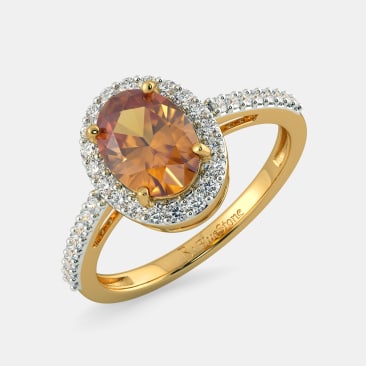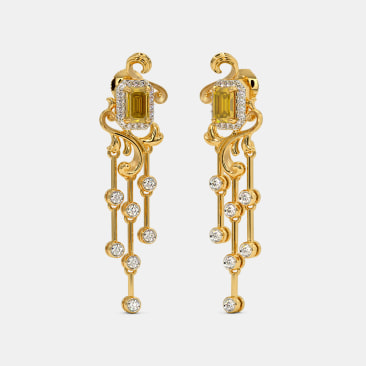Citrine
Iron is one of the most important elements known to man. You need iron to stay healthy. You need iron to build a house. And, you need iron for beautiful jewellery. Yes! It is iron that gives certain gemstones their beautiful warm colours.
You know which stone we are talking about, don’t you?
Yes, the bright, beautiful, and enchantingly yellow citrines! These yellow beauties may not be as precious as a ruby or emerald. But they indeed are rare and valuable. Citrine Earrings or pendants, rings or necklaces, jewellery made of this semi-precious stone is stunning.
But how much do you know about this stone?
Here is a quick guide on everything you need to know about these jewels. We give you a rundown of its history, features, types, buying instructions, and caring tips.
Overview
Citrines are one of the most precious members of the quartz family. Though quartz crystals are common, citrine is quite rare. The defining feature of this stone is its tawny colour ranging from a pale yellow to an orangish brown. It is often confused with Topaz because of its colour. Like most other types of quartz, citrine is affordable, durable, and attractive. On the Mohs scale, it has a value of 7. This means that is relatively hard but can get scratched easily.
History of Citrine
Citrine derives its name from the French word citron, meaning lemon. As you can imagine, the name of the stone is inspired by its colour. One of the earliest mentions of this stone is in the Bible. The stone is called chrysolitus meaning golden stone in the Old Testament. This stone was favoured by the ancient Romans and Greeks, especially during the Hellenistic Age. People used it not just for making jewellery, though. In the seventeenth century, Scottish weapons makers used it to decorate dagger handles.
It is believed that citrine was amongst Queen Victoria’s favourite stones. She often wore her citrine jewellery to parties organised in the Balmoral Castle in the Scottish Highlands. The guests for these parties were usually told to be attired in Highland Style. Thus, the citrine stone became an essential part of the Highland tradition. Even today it is often worn as brooches and kilt pins.
And then comes the Art Deco period!
During this period, designers used this semiprecious stone to make large statement pieces. Some of the most well-known of these pieces belonged to Hollywood celebrities like Greta Garbo and Joan Gawford. This beautiful yellow gemstone has been popular since the ancient times. However, it was during the Art Deco period that these stones shone bright.
Types of Citrine
This semi-precious stone can be divided into two types, namely natural and heat-treated. The difference between them is based on how they are formed.
Natural: These, as the name suggests, are naturally occurring stones. Such stones are pale yellow in colour, often with smoky hues. Brownish and orange varieties are also available. They are rare in nature and hence expensive too.
Heat-treated: Citrines are rare and hence they are often synthesised from other quartz stones. Most commercial ones available in the market today are heat-treated ones. They are formed by heat-treating amethysts. The amount of heat provided determines the darkness of the colour. While this treatment changes the colour, it does not alter the stone’s chemical properties. However, since it isn’t natural, it is not as valuable as naturally occurring ones.
Birthstones and Anniversaries
Do you celebrate your birthday in the month of November? Well, you may choose between topaz and citrine as your birthstone. It is also often gifted on the 13th wedding anniversary.
How to Identify Real and Fake Citrines?
Citrines are one of the most popular yellow stones used in jewellery making. However, people may sell you coloured glass instead of a real stone. Hence, it is important to be able to recognise some of the features of a real citrine gemstone.
When you shop for citrines, you are likely to come across three types of them. The first is real citrines aka natural citrines. They are expensive and have an even colour tone. If the stone shows undertones of other colours such as orange or green, it is not a natural one.
The second variety is cooked or baked citrines.
And guess what?
These are not even citrines. They, as we already mentioned, are heat-treated amethysts used commercially for jewellery making. Cooked citrine or citrine created in a lab typically features drastic changes in colour. The tips may be very dark while the base is still white. The location is also a good indicator of its authenticity. Check if the citrines on your jewellery are from Africa or Brazil. If yes, they are more likely to be real ones.
The third is coloured glass and the synthetic variety. These are neither citrine, nor are they crystals. They are fake ones! One of the defining features of such fakes stones is that they will appear very clear. While this may seem desirable, natural citrine usually has a cloudy appearance around the base. In the case of coloured glass, you can even notice bubbles and other glassy traits.
How to Buy Citrine Jewellery?
Citrines are available in a wide range of sizes. They are used to create delicate earrings as well as cocktail rings and large pieces of jewellery. When buying a citrine gemstone you must keep the cut, colour, clarity, and carat of the stone in mind.
Cut: In nature, these gems are available not only in a wide range of sizes but also many different shapes. Hence, they can be cut in a number of ways. The round, emerald, teardrop and princess cut are very popular. They can also be cut into unusual abstract forms for statement jewellery.
Colour: The warm colour of a citrine is what makes it special. Pale yellow stones are easily available and much cheaper than those with an orangish brown hue. The darker the colour, the more expensive the stone will be. However, when buying dark citrines, one must ensure that the stone is natural and has not been heat-treated.
Clarity: Citrines are categorised under type I clarity. The most beautiful ones are those without visible inclusions and colour zoning. Colour zoning may be seen in the form of zebra stripes or tiger stripes. Also look out for fractures when you buy citrine jewellery online or offline.
Carat: Citrines are easily available in a range of sizes up to 20 carats. Since large gemstones are not very rare, the price of the stone increases gradually with relation to its size.
How to Look After Your Citrine Jewellery?
Citrine ornaments are beautiful to see and wear. But they require proper care too. If you take care of it properly, your citrine jewellery could last a lifetime. The stone is hard and hence not easily broken but it is susceptible to scratches. Here are a few tips to help you care for your citrines.
Do not store your citrine pendants, earrings, and rings with other jewellery in a bag or box. This can lead to scratches as the gemstones rub against each other. Instead, store your jewellery in a fabric-lined box with individual compartments.
Do not wear citrine rings or bangles while doing any sort of manual work.
Protect your citrines from sunlight. The stones are sensitive to heat and excessive exposure could make the colour fade.
Do not steam clean your citrine ornaments. Avoid ultrasonic cleaning too. Instead, wash them with warm water and soap. If dirt is embossed in the jewellery, you may use a soft-bristled toothbrush to remove it.
When it comes to earth-toned jewels, there is nothing as fine as a citrine. So, are you ready to shop for one?




